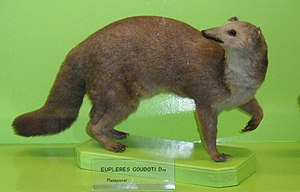Falanuk
| Falanuk | ||||||||||||
|---|---|---|---|---|---|---|---|---|---|---|---|---|

Falanuk ( Eupleres goudotii ) |
||||||||||||
| Systematics | ||||||||||||
|
||||||||||||
| Scientific name of the genus | ||||||||||||
| Eupleres | ||||||||||||
| Doyère , 1835 | ||||||||||||
| Scientific name of the species | ||||||||||||
| Eupleres goudotii | ||||||||||||
| Doyère , 1835 |
The falanouc ( Eupleres goudotii ), also known as ants Civet called, is a mammal of the family of Malagasy carnivores (Eupleridae). It lives in Madagascar and feeds mainly on earthworms .
features
Falanuks are the second largest representatives of the Malagasy carnivores after the fossas . They reach a head body length of 46 to 65 centimeters, plus a 22 to 25 centimeter long tail. Their weight is 1.6 to 4.6 kilograms. They have an unconventional physique: the torso is elongated and stocky, the feet are large and have long claws. The tail is broad and rounded, and because of the long hair it appears bushy. The head is small compared to the body, the muzzle is long and pointed, the ears are large and rounded. The teeth are striking: they are small and uniform and their structure is reminiscent of the insectivore's teeth . In their physique they show some convergences to the not closely related aardwolf .
A distinction is made between two subspecies: the nominate form E. g. goudotii has a reddish-brown fur with a light brown belly, it is the smaller subspecies with a maximum of 50 centimeters of head body length and 2.1 kilograms. The second subspecies, E. g. major has a dark brown to gray fur on the back, the belly and the inside of the thighs are orange, this subspecies is also significantly larger.
distribution and habitat
Falanuks are endemic to Madagascar . The nominate form lives in the rainforests in the east of the island up to 1600 meters above sea level. They often live near bodies of water or in marsh lands. The subspecies E. g. major lives in drier deciduous forests in western and northwestern Madagascar, for example in the regions of Sambirano and Montagne d'Ambre. The geographical distribution of the two subspecies has not yet been fully clarified.
Way of life
Falanuks are likely cathemeral , meaning they can be active both day and night. They use other animals' burrows as sleeping places or they withdraw into the roots of trees. They mainly stay on the ground, because of the long claws on their front paws they move in a lurching walk. Falanuks live solitary, with groups sometimes observed it is probably mothers with their young. They are territorial animals that mark their territory with glandular secretions. The districts are probably very large, there are no precise figures. Before the cold dry season, they can store up to 800 grams of fat in their tail, their weight can increase by up to 20%. Whether they fall into rigidity or hibernation is not known, at least in the eastern rainforests, animals have also been observed in the dry season.
The diet of the Falanuks consists primarily of earthworms , but they also eat snails , insects , frogs and chameleons . Their long snouts and claws help them rummage through the soil or the leaves for something to eat.
Reproduction
The mating takes place at the end of the dry season, between August and September, the young are born in the rainy season (November to January). The litter size is one or two. The newborns are well developed, they weigh around 150 grams, have opened their eyes and can walk after a day or two. They are weaned at around nine weeks.
threat
In the past, the tails of the Falanuks were used by the inhabitants as decorative objects. Today the destruction of the forest, feral dogs and the competition of the introduced small Indian civet cat are responsible for the fact that the populations are declining more and more and that the Falanuk is listed as " near threatened " by the IUCN .
Systematics
Traditionally the falanuk was counted among the crawling cats . According to recent genetic studies, however, it is incorporated into a newly established group, the Malagasy predators (Eupleridae). These investigations revealed that all of Madagascar's predators - which were previously run in different families - descended from a common, mango-like ancestor who crossed the Strait of Mozambique in the late Oligocene or early Miocene (around 24 to 18 million years ago) . The closest relatives of the Falanuk are the Fanaloka and the Fossa , with which it forms the subfamily of the Euplerinae.
More detailed investigations could show that the two subspecies will be listed as separate species in the future.
literature
- Ronald M. Nowak: Walker's Mammals of the World. The Johns Hopkins University Press, Baltimore 1999, ISBN 0-8018-5789-9 .
- Don E. Wilson, Russell A. Mittermeier (Eds.): Handbook of the Mammals of the World. Volume 1: Carnivores. Lynx Edicions, 2009, ISBN 978-84-96553-49-1 .
- Nick Garbutt: Mammals of Madagascar. A Complete Guide. Yale University Press, New Haven & London 2007, ISBN 978-0-300-12550-4
- Louis Michel François Doyère: Notice sur un Mammifère de Madagascar, formant le type d'un nouveau genre de la famille Carnassiers insectivores de M. Cuvier . In: Annales des sciences naturelles (= 2 (zoology) ). tape 4 , 1835, p. 270-283 ( biodiversitylibrary.org ).
Web links
- Photos and information on Arkive.org (English)
- Eupleres goudotii onthe IUCN Red List of Threatened Species . Retrieved June 22, 2009.